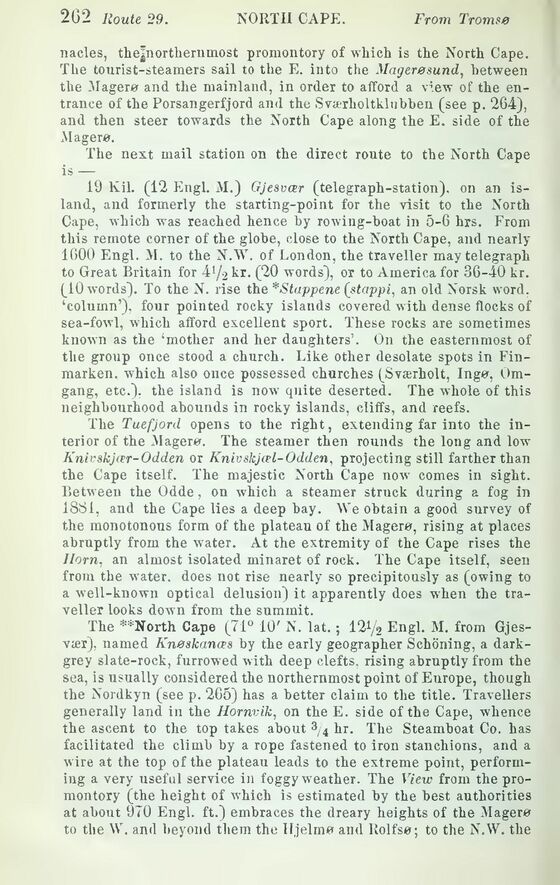
Full resolution (JPEG) - On this page / på denna sida - Norway - Pages ...

<< prev. page << föreg. sida << >> nästa sida >> next page >>
Below is the raw OCR text
from the above scanned image.
Do you see an error? Proofread the page now!
Här nedan syns maskintolkade texten från faksimilbilden ovan.
Ser du något fel? Korrekturläs sidan nu!
This page has never been proofread. / Denna sida har aldrig korrekturlästs.
nacles, the|northernmost promontory of which is the North Cape.
The tourist-steamers sail to the E. into the Magerøsund, between
the Magerø and the mainland, in order to afford a view of the
entrance of the Porsangerfjord and the Sværlioltklubben (see p. 264),
and then steer towards the North Cape along the E. side of the
Magerø.
The next mail station on the direct route to the North Cape
is —
19 Kil. (12 Engl. M.) Gjesvcer (telegraph-station), on an
island, and formerly the starting-point for the visit to the North
Cape, which was reached hence by rowing-boat in 5-6 hrs. From
this remote corner of the globe, close to the North Cape, and nearly
1600 Engl. M. to the N.W. of London, the traveller may telegraph
to Great Britain for 4[/2 kr. (20 words), or to America for 36-40 kr.
(10 words). To the N. rise the *Stappene (stappi, an old Norsk word,
‘column’), four pointed rocky islands covered with dense flocks of
sea-fowl, which afford excellent sport. These rocks are sometimes
known as the ‘mother and her daughters’. On the easternmost of
the group once stood a church. Like other desolate spots in
Finmarken, which also once possessed churches (Sværholt, Ingø,
Omgang, etc.), the island is now quite deserted. The whole of this
neighbourhood abounds in rocky islands, cliffs, and reefs.
The Tuefjord opens to the right, extending far into the
interior of the Magerø. The steamer then rounds the long and low
Knivskjar-Odden or Knivskjwl-Odden, projecting still farther than
the Cape itself. The majestic North Cape now comes in sight.
Between the Odde, on which a steamer struck during a fog in
1831, and the Cape lies a deep bay. We obtain a good survey of
the monotonous form of the plateau of the Magerø, rising at places
abruptly from the water. At the extremity of the Cape rises the
//ora, an almost isolated minaret of rock. The Cape itself, seen
from the water, does not rise nearly so precipitously as (owing to
a well-known optical delusion) it apparently does when the
traveller looks down from the summit.
The **North Cape (71° 10’ N. lat. ; 12i/2 Engl. M. from
Gjes-vær), named Knøskanas by the early geographer Scheming, a
dark-grey slate-rock, furrowed with deep clefts, rising abruptly from the
sea, is usually considered the northernmost point of Europe, though
the Nordkyn (see p. 265) has a better claim to the title. Travellers
generally land in the Hornvik, on the E. side of the Cape, whence
the ascent to the top takes about 3/4 hr. The Steamboat Co. has
facilitated the climb by a rope fastened to iron stanchions, and a
wire at the top of the plateau leads to the extreme point,
performing a very useful service in foggy weather. The View from the
promontory (the height of which is estimated by the best authorities
at about 970 Engl, ft.) embraces the dreary heights of the Magerø
to the W. and beyond them the Hjelmø and Rolfsø; to the N.W. the
<< prev. page << föreg. sida << >> nästa sida >> next page >>